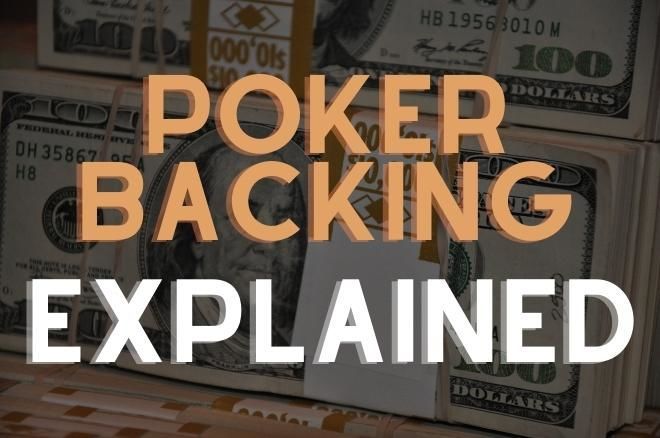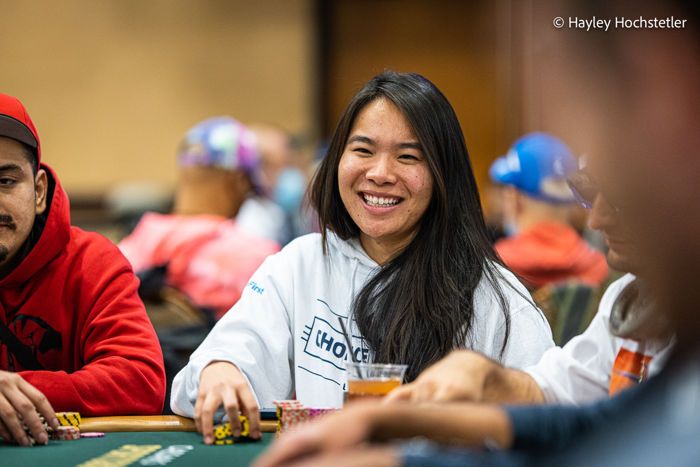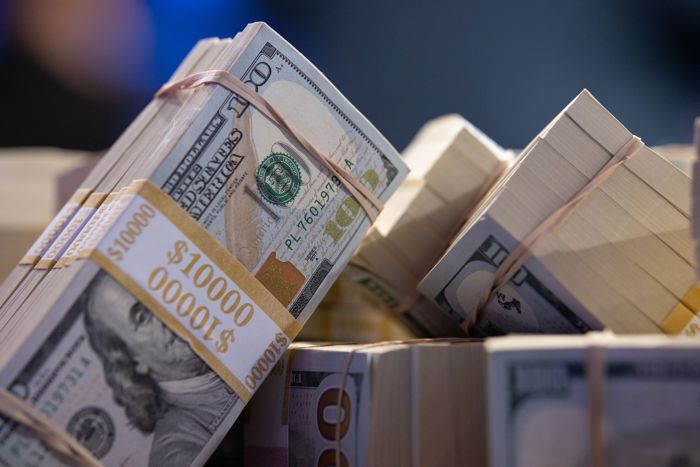
For many poker fans, the mysterious world of backing, staking and swapping in poker are complete unknowns. Conversations on these topics happen frequently between some of the best — and richest — poker players around the world, but a spotlight is rarely shone on this particular area of poker’s hidden underworld.
In a recent blog post, poker player Lynne Ji (pictured) explained in more detail about how staking deals come about, how people make money through them and why, in her opinion, you probably shouldn’t back anyone. You can read the original post here

I recently had a conversation with someone who asked me if I knew anyone who backed people for high stakes live cash ($50/$100+) right before remarking that “It seems like sooo many people lose buying action and staking, myself included lol,” which is pretty ironic, but it got me thinking:
Why do so many people lose backing and buying action?
What is Backing?
In general, people need backing/to sell action because they don’t have the bankroll to play their desired stakes on their own. And they don’t have the bankroll because they’re simply not winning (enough).
There’s a multitude of reasons why that might be the case:
- Maybe they have to work another job on the side to pay the bills so they don’t have enough time to play even if they’re winning (this is a big IF, by the way)
- Maybe they have a problematic pit game and/or sports betting problem
- Maybe they have tilt problems or freeze/put in way too many chips in high pressure spots
- Maybe their fundamentals simply aren’t good enough.
Most people that reach out to me for backing claim the first reason. Instinct and experience tell me it’s usually the third or fourth.
People who win consistently rarely need backing or to sell for long, which means out of the pool of people that are looking for outside investment, it’s reasonably skewed to people who don’t.
For these reasons (and because I’ve already lost a million dollars backing and buying action), I almost never get involved with backing people.

Types of Players You Can Profitably Back
With that said, let’s talk about exceptions to the rule, and players that you could look to back profitably. I’ll be candid, I can’t think of many.
1. Winning Players on Hard Times
A player who’s consistently won for years but suddenly had large (unexpected) bills that have severely cut into their bankroll.
The problem with these players is: People simply aren’t telling the truth often enough.
I’ve seen too many horror stories where rather than their mother getting cancer, it’s a degenerate blackjack problem or a major downswing.
I understand emergencies happen, but why didn’t you have the money in the first place? Not having the money makes me think they’re not great at managing funds, in which case, I definitely don’t want them managing mine.
If they truly had an emergency, there is often continued fallout (and expenses) to be dealt with. I have a pretty strict policy of not entering into business relationships with anyone desperate and this conflicts with that. Desperate people tend to be more rash and less ethical, and stress can severely inhibit the ability to make good decisions.
What is Swapping? Why Do Poker Players Swap With Each Other?
2. New Players
A player that’s coming up in poker AND fairly new to the game. The second part of that sentence is pretty important because if they didn’t manage to move up stakes the first few times they took a shot, why should I expect anything different this time around?
“If they didn’t manage to move up stakes the first few times they took a shot, why should I expect anything different this time around?”
The problem with these players is that as much as we joke about high stakes being soft, games tend to get tougher, or at least, trickier as games get bigger, which means that there’s probably going to be a learning curve, and unless I really like you, I don’t want to be there to suffer through them with you.
3. Serial Horses
And finally, this is a player who’s always been backed, simply because that’s how they’re used to doing things. This is usually someone who’s won on every stake they’ve been on and those stakes have typically ended for one of a number of reasons:
- Because the backer has wanted to get out of backing
- The player wants to move up stakes faster than their backer
- Or because of personal issues
The third is typically rare, because two people usually need to have a pretty good relationship to start a backing agreement and because people like people that make them money.
I like backing this type of player. Especially if their previous backers can vouch for their character and poker ability. Unfortunately, these players don’t come along all that often and they tend to know their worth, which they often exhibit in the form of a demand for a more favorable profit split.

How to Back Profitably
Hopefully, you’re slightly less inclined to back people now. Buying action is a much better deal for the investor as you’re not paying the markup inherently built into staking and it’s much simpler to do on a per session basis where you’re not married to your horse.
HOWEVER, if you’re still chomping at the bit to back your friend, girlfriend, or nephew, here are a few things you could do to make the agreement more favorable for yourself.
Poker Bankroll Management in 2022: An Introduction
1. A Profit Buffer
As far as staking goes, usually the backer and the horse profit chop anytime the horse is in profit which means, besides the few short moments between when a win has been booked and when you next settle, the number on stake is always 0 or negative.
Makeup is inevitable, but being in a lot of makeup is no bueno for a variety of reasons. Players already tend to play worse on a downswing, and being in a lot of makeup tends to increase stress (for both parties), decrease motivation, and encourage shady behavior.
One of the ways we can decrease the likelihood of a horse being in a lot of makeup is to implement a profit buffer.
The easiest way to explain how a profit buffer works is by giving an example. Let’s say a backer, Ana, has stipulated a $20,000 profit buffer with her horse, Candace. That means, not a penny of profit gets chopped UNTIL Candace wins $20,000 on stake.
Let’s say Candace had a good first session today and won $23,000. From what she won, $23,000 of that stays “on stake” and Ana and Candace chop $1,500 each.
Next session, Candace runs bad and loses $10,000. Instead of being in $10,000 worth of makeup, the number on stake is now +$10,000.
2. A Less Favorable Profit Split
I’ve seen this done in a variety of ways. The simplest is for the first $X a horse wins, they get a 30/70 profit split (30% for the horse, 70% for the backer), then for the next $Y, it 40/60, and so on.
Generally, backers insist that the horse leave the profit on stake to realize the increase in their profit split, so for example, let’s say for the first $100,000 of profit, the horse gets 30%. When the amount on stake is between $100,000-$200,000, they get 40%, and so on, that would mean that the horse can’t profit chop until they hit $100,000 if they want to “move up to the next tier” and receive 40% of the profit, but once they do, they get the additional 10% on the total amount.
A couple of other ways backers have done it is by:
- Method A: Giving horses the improved profit split without insisting the horse leave the profit on stake, because theoretically, they’ve now already made you some money and proven it more likely that they’re a winning player
- Method B: Only giving their horse the improved profit split on the additional profit. For example, if they want to chop $120,000 in the example provided above, they get 30% of the first $100,000 and 40% of anything over that amount (the next $20,000) for a total of 38k, rather than 40% of the total profit ($120,000) for $48,000.
I don’t have strong feelings about Method A where the horse doesn’t have to leave their profit on stake, because while that protects the backer quite a bit, it simply isn’t feasible for a lot of horses who need the money.
I dislike Method B because horses are far less incentivized to leave profit on stake when they only get the improved profit split on the additional profit, and I think it’s valuable to reward delayed gratification especially when it simultaneously protects your own interests. (The horse leaving money on stake functions similarly to a profit buffer.)
3. Get Them Coaching/Study Tools
Unless you’re working with player type 3 (mentioned above), you probably don’t have a winning player on your hands. And even if you do, additional coaching and an improved hourly only helps your horse’s ability to make the two of you money. For that reason, I generally encourage backers to either personally provide coaching/resources (ranges, study tools, etc.) or to prove their horses with access to them.
I like putting costs associated with coaching and studying on stake, so for instance, if the current makeup number is $2,000, and coaching costs $500, the new makeup number is $2,500, because I find it to be a win-win.
Do You Know ALL the 14 Best Poker Training Sites in 2022?
It doesn’t hurt the backer, because as long as your horse eventually gets out of makeup, you get 100% of the money you’ve paid back and it’s good for the horse because now you just got coaching with $ you didn’t pay for out of pocket. You’re charging it against your future earnings, which is okay, because you just gave the future you the gift of a higher win rate!
